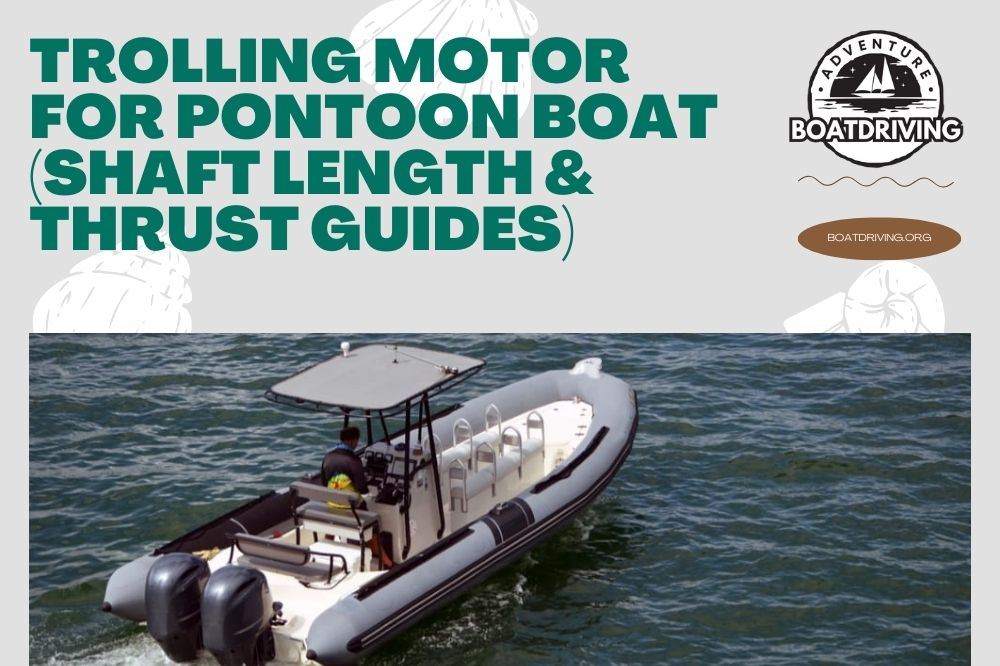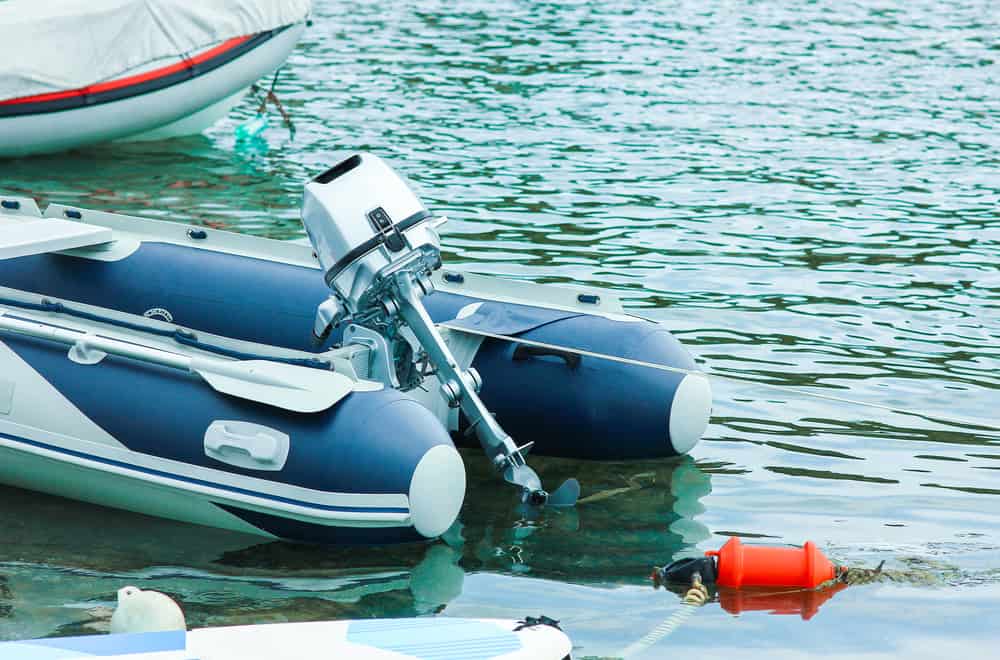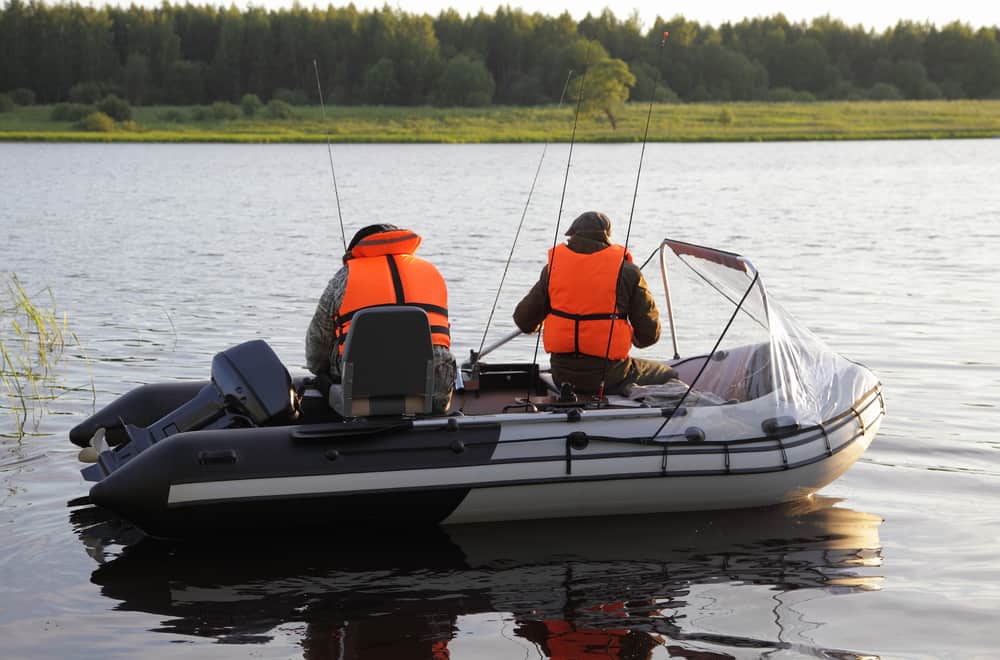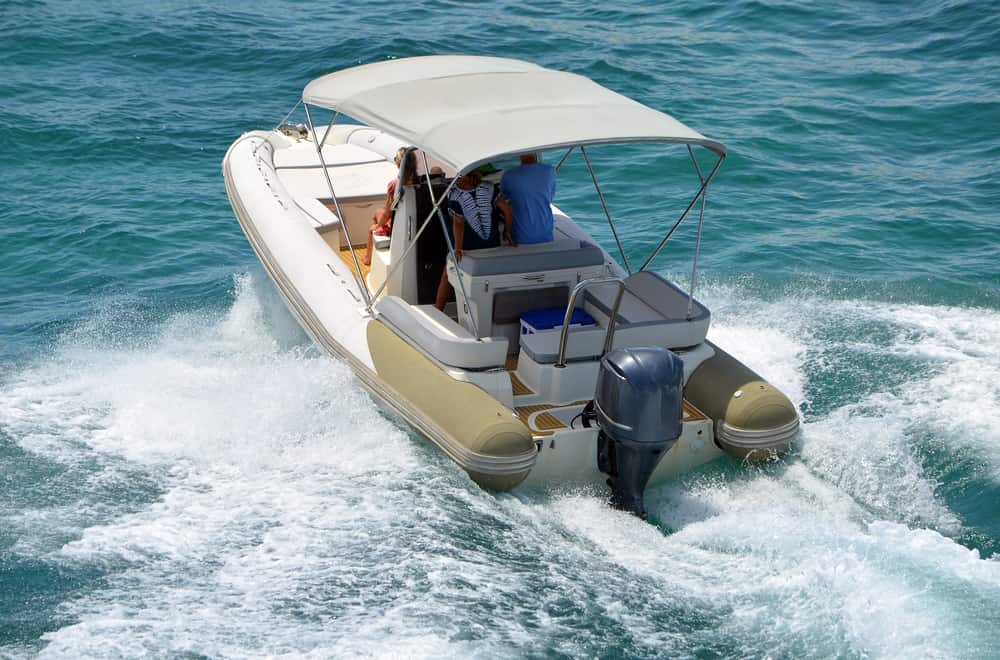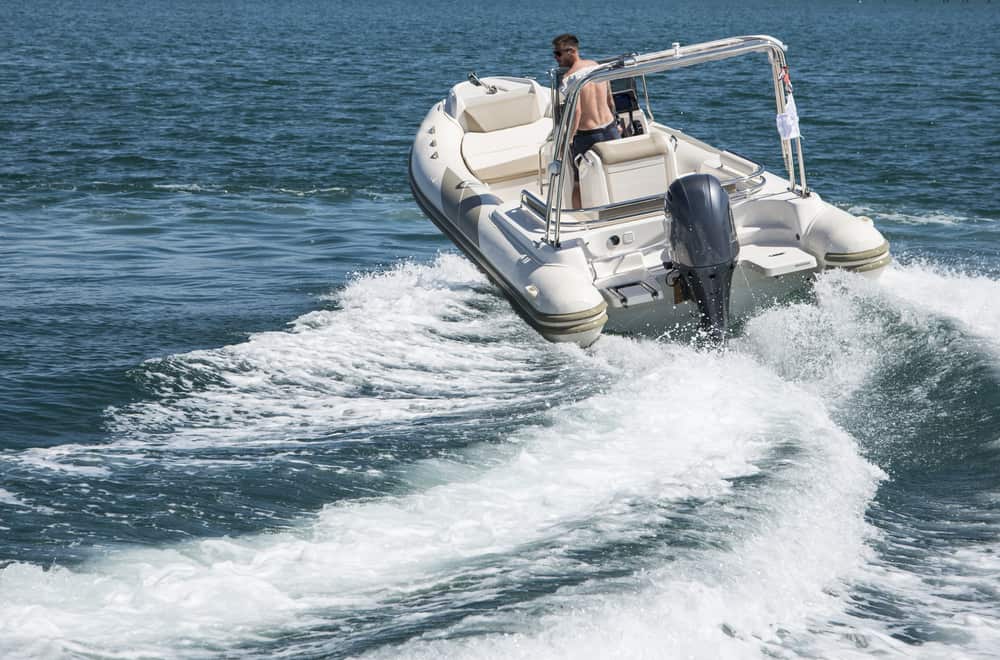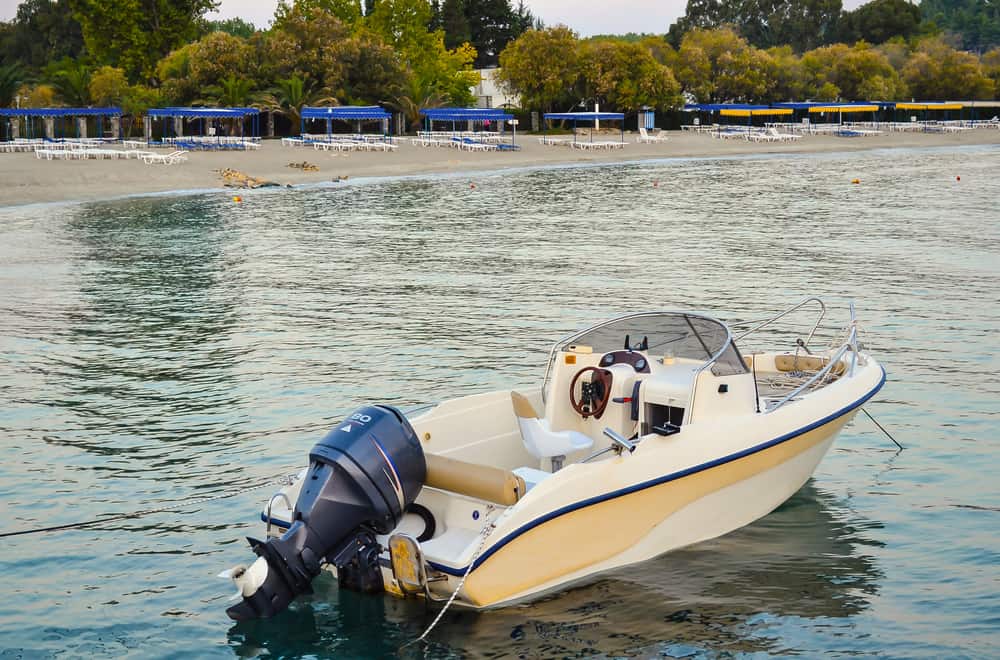You may be happy to know that specific trolling motors are appropriate for powering your pontoon boat. The two most important factors to consider when searching for a suitable motor will be its shaft length and its rated pounds of thrust.
Table of Contents
What About Thrust?
Trolling motors rolled out as a secondary propulsion system designed to be lightweight, quiet, and stealthy. For that reason, trolling engines are most often electric-powered.
However, if you come across fuel-powered trolling motors during your search, please note that people refer to a small 2-3.5 horsepower outboard motor utilized for trolling or other special needs.
Since trolling motors are usually electric-powered, manufacturers annotate their power rating by pounds of thrust, not horsepower. This is because pounds of thrust measure force, whereas horsepower measures how much work an engine produces per unit.
But because people are more accustomed to using horsepower, manufacturers will usually include a comparison chart in their modern trolling motor description.
“Generally speaking, 75 lb. of thrust is roughly equal to 1 gas engine horsepower,” according to the math conversion gurus as PaddleCamp.
Remember, though, that there is more to it than just finding the biggest trolling motor.
How To Calculate Trolling Motor Thrust for Pontoon Boat?
Minn Kota, a leading trolling motor manufacturer, recommends that you have “at least 2 pounds of thrust for every 100 pounds of fully-loaded boat weight.”
At this point, I recommend that you look at your pontoon boat and find the legally required capacity plate. This plate should be in plain view and easily recognizable by its bright coloring.
Capacity plates outline various weight and power limitations of your vessel. Commonly, this decal affixed to your pontoon boat will have three main categories:
- MAX PERSONS OR POUNDS – Measured by the number of people or pounds, this is the total weight allowed for your passengers.
- MAX WEIGHT – Also measured in pounds, this number represents your boat’s total weight capacity, including persons, gear, and motor.
- MAX HORSEPOWER – This unit allocates the maximum power your boat can handle.
Please note that the capacity plate will likely not measure the engine power in terms of pounds of thrust. However, this does not excuse you from abiding by federal regulations- be sure to calculate the proper conversions for your trolling motor to ensure you stay within guidelines.
But when shopping for a suitable trolling motor, you need to consider various factors beyond the weight of your fully-loaded boat, such as wind conditions and current.
Let’s work through an example together to give you a better understanding of the relationship between boat weight and thrust when searching for a suitable trolling motor.
Say your pontoon boat weighs 2,000 pounds dry, but you likely add 1,000 pounds to the mix with motor, gear, and passengers. So if we follow suit with Minn Kota’s recommendations, here is the math:
3,000 lb ÷ 100 = 30 · 2 = 60 pounds of thrust
How Much Trolling Motor Thrust for Pontoon Boat?
Given you have a fully loaded pontoon boat weighing in at 3,000 pounds, you should not look at anything with a minimum rating below 60 pounds of thrust.
Consider one more thing- pontoon boats are distinct from other v-hull boat designs in that they take advantage of buoyancy to keep afloat. Pontoon boats essentially have a flat deck with attached supports (floats) on their underbody.
The flat deck is an excellent feature that families and boat enthusiasts like me and you love because we have lots of freedom to accessorize our pontoon to our personality and needs.
In addition, pontoon boats boast high-capacity storage and are relatively easy to operate and maintain. Pontoon boats can also be used in freshwater and saltwater conditions, having good versatility and range.
Let me point out that their flat deck system significantly reduces their hydrodynamics. For instance, in choppy waters, a pontoon boat will attack the waves by plunging right into them versus a v-hull design that would ride over them.
The numerous technical resources I have come across boost the minimum thrust figure we calculated by ten pounds. So for your 3,000-pound pontoon boat, you should find a trolling motor with a minimum output of 70 pounds of thrust.
Voltage Requirements
Larger trolling motors require more electrical power. Voltage refers to the amount of charge a particular trolling motor can handle. It also is relative to the achievable thrust output when fully charged.
For example, if you see a 24V/ 80 lbs thrust trolling motor when shopping around, know that the engine will generate 80 pounds of thrust powered by a 24-volt battery.
PRO-TIP: If you plan to be on the water in your pontoon for extended periods, keep an additional battery or two in that coveted extra storage you have aboard.
Trolling Motor Shaft Length for Pontoon Boat
Since you own or are thinking about purchasing a pontoon boat, its distinct design requires some special consideration for a suitable motor shaft length because its deck sits much higher above the water than other typical boats.
Usually, to determine shaft length when retrofitting a boat with a trolling motor, you would first measure from the top of the transom (rear cross-section) to the waterline.
Under normal circumstances, Minn Kota recommends that “the center of the motor section [be submerged] at least 12 inches.” However, pontoon boats generally utilize a shaft length of no less than 55 inches for a trolling motor.
Because of its higher deck, you should add 20 inches to the waterline measurement you have taken for an appropriate shaft length. Remember this is a generally accepted guideline; however, the specific shaft length depends on several factors, including:
- Specific model (and measurements) of your pontoon boat
- Water conditions such as waves and current
- The mounting location of the trolling motor (bow or transom)
The shaft length of the trolling motor ensures that your propeller remains adequately submerged in the water in various conditions. If your shaft length is not measured to fit your boat, you will experience cavitation and possibly even engine damage.
Best Mount Locations For A Trolling Motor
Selecting a trolling motor with the proper shaft length will be related to the location where you decide to mount the motor.
When it comes to pontoon boats, there are generally three common places to mount the trolling motor:
- bow (front of the boat)
- transom (rear of the boat)
- engine (yep, fit the trolling motor directly on your primary motor)
Bow-mount
It is best to mount a trolling motor nearest the center-line of a boat, so for pontoon boats, this generally means directly in front of the entry gate. However, the trolling motor becomes somewhat of a hazard and creates an obstacle for people and children entering and exiting the boat.
Pontoon boat owners have had to deal with this inconvenience for some time; however, I came across the RideRestyle company that has worked hard to design a solution for us all.
RideRestyle manufactures the quick-release Toon Troll mounting bracket to keep that trolling motor out of the way without sacrificing performance-related location.
Transom-mount
People usually mount their trolling motor on the transom of a boat nearby the primary propulsion motor. Though you may or may not be utilizing anything besides a trolling motor, transom-mounted engines work by pushing you through the water.
Transom mounted trolling motors are regularly less expensive and require less complicated installation procedures. However, boat owners of transom mount motors lose out quite noticeably on steering control.
In comparison, elite anglers and professional boaters will often opt for the more precise steering control and maneuverability associated with the pulling action of a bow-mounted transom motor. But these advantages come with a heftier price tag and usually require some extra brackets for proper installation.
Engine-mount
If you do not want the trolling motor to occupy any additional space, then pay a little extra for the convenience involved with having a trolling motor that mounts directly to your outboard engine (if you have one, that is).
Minn Kota no longer offers various engine mount trolling motors; however, you could contact your local boat dealership for products similar to the MarineTech Navigator in 55 or 110 pounds of thrust configurations.
Quick Tip Guide For Selecting a Trolling Motor
- Find your boat’s Capacity Plate.
- Convert posted HP rating to pounds of thrust.
- Decide on the most convenient mounting location for your setup.
- Consider Thrust, Voltage, & Shaft Length based on your intended use and local water conditions.
- Properly install trolling motor (include quick-release brackets and always use a tether to secure the motor to a fixed point on your boat)
- Enjoy your pontoon boat!
Conclusion
Pontoon boats can perform very well with nothing more than a trolling motor, provided that it meets the thrust and shaft length requirements for your specific model pontoon boat.
Remember to consider the maximum weight load and water conditions in the environment you intend to travel to so that an authorized dealer can help you find the most suitable trolling motor for your needs.
If you need any further assistance in finding a trolling motor for your pontoon boat, please leave your questions or concerns in the comment section below.

Joseph Fabiano is a writer, nature enthusiast, and stay-at-home father of two wild and free boys. He enjoys starting his day with a good run, hot mug of coffee, and a jump in the Ionian Sea, no matter the weather. Currently based in the Apuglia region of southern Italy, he enjoys discovering the world with his best traveling buddies (his little monkey’s and beautiful wife) at every given opportunity. Every trip, long or far, should be made an adventure according to Joseph as he believes inspiration and creation is right in front of you.
